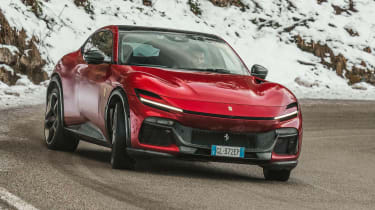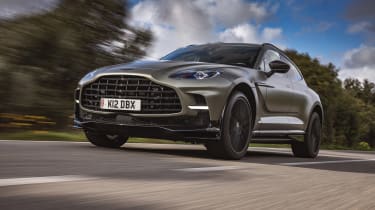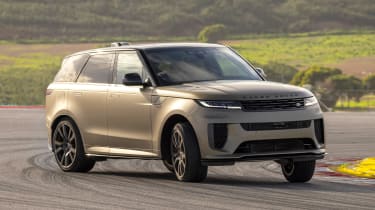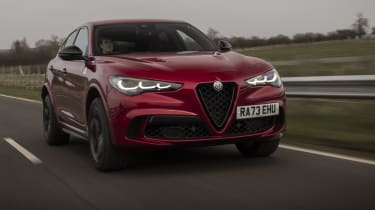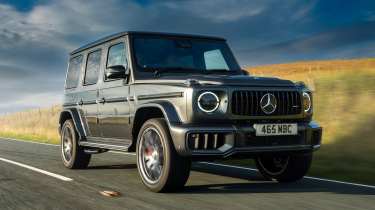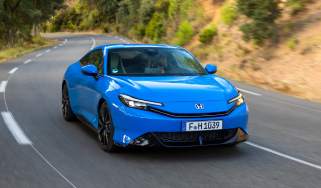Best performance SUVs 2025 – family-friendly supercars on stilts
The best hot SUVs offer entertaining dynamic characters all of their own – even if we'd rather drive an equivalent fast estate...
SUVs by their very top-heavy nature are never the last word in dynamics and driver engagement, even if manufacturers have extracted some truly biblical performance out of them over the years. That said, with iteration, new technologies and a couple of generations to iron out the kinks, some truly epic performance SUVs have broken the mould in recent years. You only need a short drive in the likes of a Porsche Cayenne GTS, Aston Martin DBX707 or Alfa Romeo Stelvio Quadrifoglio to realise that these are cars that have earned their stripes, that have been engineered to sit proudly in dealers alongside 911s, Vantages and Giulias. The numbers they sell in and the profit margins they bring also help keep those more specialised, brand-defining models alive.
You can get anything done with globs of money and engineering mastery, which is why there’s now a Range Rover that’ll drift most of Portimao, and why there’s a five-seat four-door Lamborghini with an off-road ‘Terra’ mode. Land Rover has even stuffed the engine from a BMW M5 and hydraulically cross-linked suspension into a Defender, with the result being akin to a trophy truck with number plates.
Between their titanic powertrains and new-age chassis hardware – from electronic anti-roll bars and active hydraulically-linked independently-controlled suspension to colossal brake packages – the reality is these are some of the most technically impressive and dynamically innovative performance cars on sale right now.
Of course, high-performance SUVs are always a compromise, and we’d much prefer this level of focus be put into more agreeable genres of sports car, but the market speaks, and as it stands it would almost seem foolish for a high-performance manufacturer to be without the financial liberation SUVs can provide.
So here are our favourite performance SUVs on sale in 2025
Top ten best SUVs 2025
- 1. Land Rover Defender Octa
- 2. Ferrari Purosangue
- 3. Aston Martin DBX707
- 4. Range Rover Sport SV
- 5. Porsche Cayenne GTS
- 6. Alfa Romeo Stelvio Quadrifoglio
- 7. Lamborghini Urus SE
- 8. Bentley Bentayga Speed
- 9. Mercedes-AMG G63
Land Rover Defender Octa
Did Land Rover really need to build the Octa given it already has a 5-litre nigh-on 500bhp V8 model in its line-up? If you happen to have a talented team of Special Vehicle Operations techs in the building it would have been rude not to and the resulting machine is truly staggering, redefining how we feel about the super-SUV. Its hardware demonstrates its intent – a 626bhp BMW M-sourced V8, trick hydraulically-linked continuously variable semi-active dampers and 400mm Brembo discs tell half the story, but the Octa’s special talent lies in the way it combines all of it’s elements on- and off-road.
On the road the Octa is unexpectedly impressive, shrugging off the numbness and remote feeling that regular Defenders have, replacing those less-than-ideal attributes with a level of agility and ability that defies its 2585kg kerb weight. It’ll lift up its skirts and fly when you ask it, knocking off the 0-62mph sprint in 3.8sec when launch mode is activated which adds an additional 37lb ft to its already impressive 553lb ft torque peak.
It's equally impressive off-road too, dispatching rock climbs, gravel special stages or rugged tracks. It even has a high performance off-road setting where it’ll do a pretty good impression of a Group A rally car on a special stage. Ultimately the Octa a hugely impressive achievement with far more substance and capability than we were expecting – it really is quite the machine.
> Land Rover Defender Octa review
Ferrari Purosangue
The Purosangue is undoubtedly the most divisive, unusual and complex SUV on sale, but somehow, Ferrari's engineers have moulded it into the most exciting of all to drive. Take one look at its technical specification and it's not hard to see why; with an astonishing 6.5-litre V12 up front generating 715bhp the Purosangue has the noise, drama and performance of a traditional Ferrari GT, even if it looks unlike anything we've seen from the brand before.
There's more under the skin. Ferrari has developed a unique suspension technology specifically for its first SUV, which uses electric motors to control the damping forces on the move to counter body roll and absorb bumps in a way that feels alien to most lead-footed, conventional SUVs.
The results are staggering on the road. Yes, the Purosangue sometimes feels synthetic and hyper agile in a way that reveals its electronic complexity, but no SUV feels as fluid, characterful or as playful at the limit.
But while the Purosangue feels more like a sports car than other car of this type, it's also deeply impractical compared to rivals like the Aston Martin DBX707. With four seats and a compromised luggage area, Ferrari has sacrificed some of the usability you'd expect from an SUV to deliver the most engaging, exotic car in the segment.
Aston Martin DBX707
The thought of an Aston Martin SUV might make some enthusiasts squirm, but the DBX is one of the most desirable cars of its type – more rounded (and less ostentatious) than a Lamborghini Urus and more special than hot versions of more mainstream rivals from the likes of Range Rover, BMW and Audi.
The DBX707 is a dramatic step on from the original, with mechanical upgrades and an overhauled cabin with a new infotainment system. The Mercedes-AMG’s 4-litre hot-V twin-turbocharged V8 has uprated ball bearing turbos, a redesigned exhaust system and revised mapping to produce 697bhp and 663lb ft of torque, driven through a nine-speed auto with a shorter final drive. All that means a 0-62mph time of 3.3sec, and a top speed of 193mph. Thankfully, ceramic brakes come as standard.
As striking as straight-line performance figures can be, though, this isn’t where the Aston is most impressive. Instead, it’s the way it blends a fluid, GT-like feel with hot-rod performance and entertaining dynamics when the right buttons are pressed. Aston’s SUV has since been updated once more, with the new DBX S packing even more power (717bhp), a 47kg weight saving and a retuned chassis, as well as a cabin redesign to bring it into line with the Vantage, DB12 and Vanquish.
Range Rover Sport SV
The previous-gen Range Rover Sport SVR was enormously fast and dripping with character, but for some, the rip-snorting V8 SUV was too brash to blend into everyday life as a Range Rover should. The fact that most were bright blue and fitted with 3D number plates didn't do much for its image, either.
For the new Sport SV, Land Rover has turned things around. With a stonking 626bhp 4.4-litre V8 it's a good deal faster than before, but all that potential is clothed in a more subtle design that doesn't draw as many eyeballs as before.
Do you need carbonfibre wheels on your 2560kg performance SUV? Probably not, but specifying these and the SV's optional carbon ceramic brake package saves over 70kg in unsprung mass, enabling a 3.6sec 0-62mph time.
It has the chassis to back up the firepower, too. The SV uses clever cross-linked hydraulic suspension – similar to what you'll find on a McLaren 750S – to deliver a blend of comfort and control that's up there with the very best SUVs on the market. It even makes a decent impression on track, with a precise, honed feel and an exploitable balance. Few customers will ever explore this ability, but it's good to know that Land Rover has engineered it into the SV.
Porsche Cayenne GTS
It’s the sporty SUV that started it all. When Porsche first announced it was putting its iconic badge onto something that wasn’t a low-slung sports car, there was outrage. Porscheophiles were out for blood, incensed that such an abomination should be signed off.
Then the first-generation Cayenne arrived, and once the outrage over the dilution of the brand (and the heinously ugly looks) died down, it became evident that Porsche’s chassis engineers had worked some magic on the Cayenne. It became a sales hit and can, in addition to Porsche’s early-noughties salvation, be credited with the rise of sporty SUVs.
Even with the proliferation of fancier rivals from proper supercar manufacturers, the Cayenne is still one of the best to drive. At the top of the tree is the monstrous, 729bhp Cayenne Turbo E-Hybrid, equipped with a twin-turbocharged V8 and a plug-in hybrid system. An optional GT Package transforms it into a more driver focused SUV with suspension geometry upgrades, ceramic brakes, carbonfibre exterior elements and a titanium exhaust.
But it’s the Cayenne GTS that’s arguably the sweet spot of the lineup, at £33k and 300kg less than the monstrous hybrid. No it’s not a flyweight but that’s far from an insignificant difference and the GTS is lighter on its feet as a result. ‘Just’ 493bhp might make it the motive minnow of this crop but that just means you can revel in the 4-litre twin-turbo V8’s personality for longer before speeds get silly.
Alfa Romeo Stelvio Quadrifoglio
We adore the Giulia Quadrifoglio, but alongside the brilliant saloon there’s always been its Stelvio cousin, which is almost as good. Unlike almost all of the other options on this list, the Stelvio is relatively lightweight, its edges raw and its character dominant in a class usually defined by the lack of it.
The facelifted Stelvio Quadrifoglio packs the same muscular 513bhp 2.9-litre twin-turbo V6 as its saloon namesake and is capable of a sub-four-second 0-62mph time. The V6 is mated to the familiar eight-speed auto, recalibrated for its SUV application and teamed with Alfa’s Q4 all-wheel-drive system. It’s this all-wheel-drive system that helps the Stelvio feel distinct from the saloon, trading a little of its ultimate agility and precision for the sake of improved traction.
Left in its automatic mode it’s well-mannered and rapid above 3000rpm, but you’ll need to engage Dynamic or Race mode to feel the full force of the V6 with a sharpened throttle response and reduced shift times.
Powertrain aside, the Stelvio Quadrifoglio has a highly entertaining chassis, with the same quick-witted steering feel you get in the Giulia – combine this with strong brakes and decent body control, it’s surprisingly engaging to punt along at speed.
> Alfa Romeo Stelvio Quadrifoglio review
Lamborghini Urus SE
We’ll leave the debate as to whether companies such as Lamborghini and Ferrari should be offering SUVs to another day, but the sector is undeniably popular and thus tempting for marques in the business of big business (and bankrolling low-volume supercars that shore up brand image). Lamborghini got in early as the first proper supercar brand to approach the SUV genre in this new era. Revealing the Urus all the way back in 2017, it swiftly reaped the rewards, with the model delivering Lamborghini the deliciously lucrative combination of high sales volumes and high profit margins. Post-pandemic the Urus evolved into a two-pronged lineup, in the Urus Performante and Urus S. Both pure-petrol, each featured the Lamborghini-fettled version of the Volkswagen Group 4-litre twin-turbo V8 putting out 657bhp and 627lb ft of torque.
They were potent enough for most but compared to 2024’s Urus SE and indeed, a number of rivals also listed here, 657bhp is chump change. The newly hybridised Urus SE now puts a combined 789bhp and 700lb ft underfoot. It might be the fastest Urus yet – good for 0-62mph in 3.4sec – but it’s also the most versatile, being also capable, in theory, of 37 miles of all electric driving.
As with virtually all performance SUVs there are a plethora of different driving modes to choose from, but it doesn’t take too long to settle on a setting that suits most driving situations. On smooth surfaces the Urus’s chassis can deliver physics-defying agility, but rougher roads upset its composure, especially with ludicrously large 22- or 23-inch rims.
The Urus SE goes some way to rounding off the rough dynamic edges of the original ICE-only Uruses. It’s also a marginally more attractive thing to behold, relatively speaking of course…
Bentley Bentayga Speed
What is there to say about Bentley’s SUV that hasn’t already been said? It’s fast (193mph), heavy (2500kg-ish) and expensive, with V8 and V6 hybrid powertrains available, as well as two bodystyles – standard and extended wheelbase. It’s always been a divisive car, in concept and in the way it looks, but it continues to fight near the top of the SUV tree with a compelling blend of luxury, comfort, refinement and huge pace – especially in Speed trim.
The latest Speed ditches Bentley’s traditional W12 engine, in its place a twin-turbo V8 with 641bhp. The performance is faintly absurd, with the Speed cracking 62mph in a supercar-rivalling 3.4sec and pulling to over 190mph, and thankfully Bentley has installed a suite of chassis tech to manage it all. There’s revised adaptive damping, four-wheel steering, an e-diff and optional ceramic brakes, all of which gives the Speed a level of dynamic ability that doesn’t square with how it looks, or how much it weighs.
It’s not as sharp or exuberant as the most aggressive versions of the Porsche Cayenne or Lamborghini Urus, but it’s far more luxurious than both. It’s a decade old now, but the Bentayga still has a blend of opulence, quality and performance that not many high end SUVs can match.
> Bentley Bentayga Speed review
Mercedes-AMG G63
Whereas Land Rover completely modernised the Defender to create the current model, Mercedes designed the latest G-Class through rose-tinted glasses. It looks pretty much as it always has, its squared-off bodywork reminiscent of the 1979 original, but beneath the skin lies a tech-packed interior, some modern chassis hardware, and if you go for the full-fat AMG G63, a 4-litre twin-turbo V8. It doesn't make much sense on paper, but in practice the G63 is undeniably appealing, and would have even the most hardened cynic cracking a smile at just how ludicrous it is.
577bhp in a breeze block with side-exit exhausts will do that. The G63 is a symbol of excess, and objectively not a patch on more sophisticated and dynamic performance SUVs like the Defender Octa and Aston Martin DBX. But that's not the point. The G63 is all about feel-good factor, from its looks to its bombastic engine and the satisfying chink when you shut the doors, and the current version backs this up with more refined road manners than ever.
Again, it's no sports car on stilts, but standard Active Ride Control suspension and adaptive damping helps control the body and absorb bumps, to the point where driving a G-Class is no longer a chore. You could happily use it as everyday transport without the novelty wearing off.



